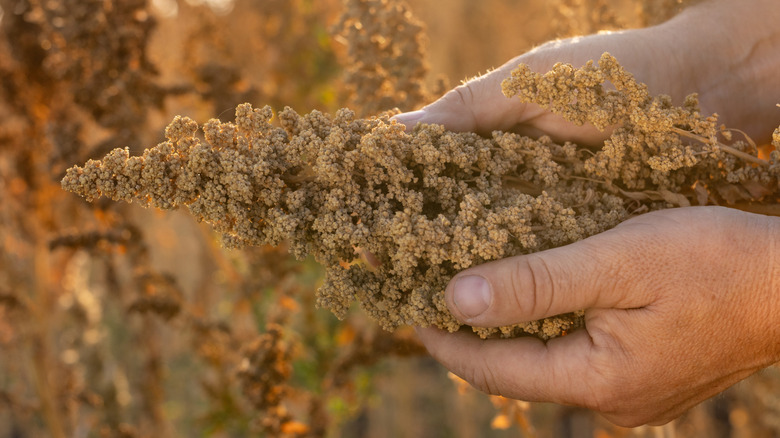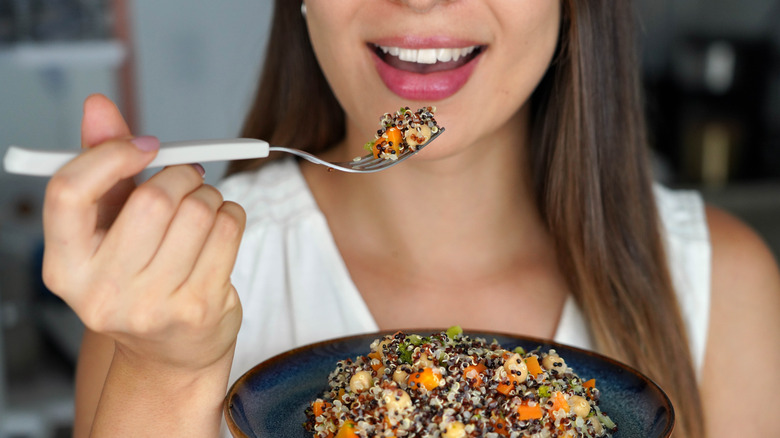A High-Protein Grain Known For Improving Heart Health Is Also Full Of Zinc
Eating foods known to keep your heart in tiptop shape is one of the ways you can lower your chance of developing cardiovascular problems. And taking care of your ticker makes sense: Based on 2022 statistics, the Centers for Disease Control and Prevention named heart disease as the reason for about one in every five deaths.
Fortunately, there are plenty of heart-friendly foods available to keep you from getting bored with your diet, including a high-protein grain called quinoa. Though quinoa's been around for generations, it's not necessarily an everyday staple in American households. Pronounced "keen-wah," quinoa hails from South America, where it's been eaten for thousands of years.
Though quinoa is technically categorized as a pseudocereal (which means its seeds are eaten rather than the plant itself), it can be a suitable alternative for nearly any grain. However, it offers more protein than many grains, including protein-rich brown rice (often at the top of "Which is the healthiest type of rice?" lists.) A single cup of cooked quinoa clocks in at around 8 grams of protein. In contrast, the same amount of cooked brown rice offers 4.5 grams of protein.
A pseudocereal that's big on heart benefits
While quinoa's protein content makes it worth consuming for your heart, it's not the only reason why the pseudocereal is considered cardioprotective. A cup of quinoa also has 5.2 grams of dietary fiber; in clinical studies, fiber consumption has consistently been linked to improved cardiovascular health.
For instance, a 2025 review in Nutrients observed that when individuals increase their intake of fiber, they could decrease their risk of cardiovascular disease. Similarly, a 2022 review in Frontiers in Nutrition found that cardiovascular disease risk factors declined in conjunction with a rise in fiber consumption.
You'll also get a boost from quinoa's whopping dose of zinc: Every cup of cooked quinoa provides you with enough zinc to make up around 18% of the daily zinc you need. Zinc has a role in regulating your metabolism, immune system, ability to smell and taste, and ability to heal. If you didn't get enough zinc, you'd start to notice eventually. For instance, you might catch more colds or take longer to recover from minor wounds. But your body can't make enough zinc to sustain you; it relies on you ingesting zinc through outside sources.
Considerations before adding quinoa to your diet
There's no doubt that quinoa has lots of unexpected health benefits. Nonetheless, it can occasionally cause allergic reactions.
For instance, some individuals are sensitive to the saponins on the coating of the quinoa shell. Sometimes, simply soaking and washing quinoa thoroughly before cooking it can remove the offending saponins. Like saponins, the oxalates in quinoa may also trigger allergic and systemic responses.
Therefore, pay attention to the way your system responds after you start eating quinoa. If you experience gastrointestinal distress, swelling of the face, difficulty breathing, a breakout of hives, respiratory problems, or other signs of a potential allergy, stop eating quinoa. Also, be sure to get immediate treatment if your reactions are potentially life-threatening.
What if you're not sensitive to saponins or oxalate, but you have a gluten intolerance or celiac disease? You may want to consider quinoa, because it's a gluten-free pseudograin. In fact, you might even find that your gluten-related problems improve after bringing quinoa into your kitchen. That's what happened for the participants of a 2014 study in the American Journal of Gastroenterology. After consuming 50 grams of quinoa daily for six weeks, they did not experience negative gastrointestinal effects, and even showed a "mild hypocholesterolemic effect."



